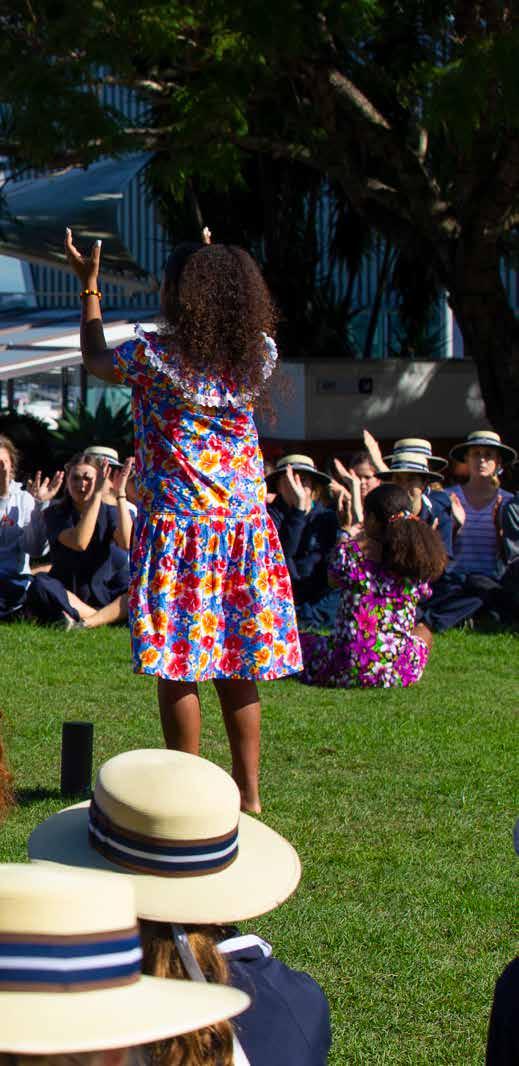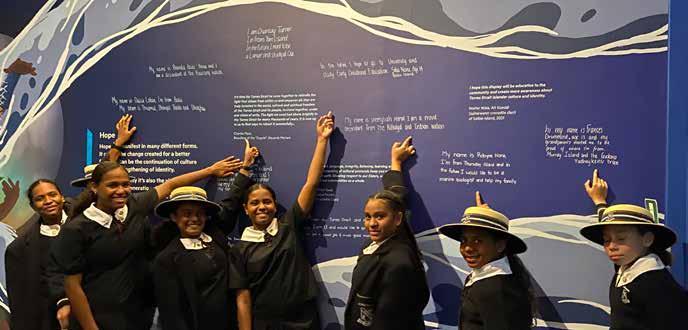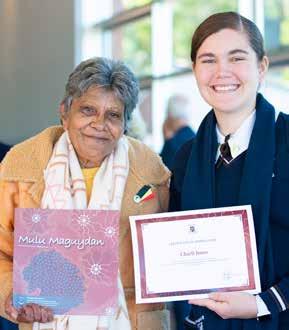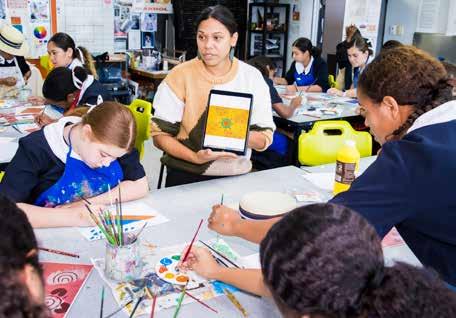
5 minute read
Mulu Maguydan
Mulu Maguydan (pronounced moo-loo moog-eye-dun), which means Story Stone, was the culmination of 18 months of the students exploring their own families’ stories, interviewing, making drafts, refining and learning how to access the art of storytelling through incursions and excursions.
As a former journalist, English teacher Margot Shave truly knows the impact of storytelling and saw it as a powerful medium through which First Nations students could access and author their own and their families’ stories to enhance both their student experience and their sense of belonging at St Margaret’s, while also enriching the lives of everyone in the community.
Margot says the families were not in the least reticent to share their stories – they were so pleased to be asked and were abundantly willing to share their lives and those of their Elders’ who speak openly about both the good times and the troubled times and their hopes for the future.
Last year the school was proud to launch a second anthology of stories authored by our First Nations students – this time with a focus on the stories of their Elders. continue over

Both volumes of these anthologies have unearthed incredible stories, both tragic and triumphant, as well as gifted artistry in the form of poetry, prose, and visual arts.
The newly refurbished St Margaret’s staffroom in Toorak now boasts two beautiful pieces of artwork gifted to the school by Joey Laifoo, the father of Indira Laifoo (’19), following the publication of the first anthology Ghidal.
Joey is an internationally recognised Australian artist with works in the Queensland and National Art galleries, so it is a great honour for the school to be able to showcase two of his pieces.
Ms Shave says we had not even realised he was an international artist.
‘This has been the magic of the process of producing these two anthologies. We have uncovered so many gems of stories, learned of interesting and fascinating lives, and gained insights into First Nations culture, made all the more accessible, as this has been shared with us by members of our school community.
‘For me, these paintings symbolise what has emerged from this entire process – a growing shared understanding and appreciation of our First Nations people, which has added to our own reconciliation story and speaks very powerfully to the school’s value of inclusivity,’ Mrs Shave said. The saying ‘if you can see it, you can be it’ guided teachers Ms Shave and Noel Peinke to ensure our First Nations students, in the process of researching and learning how to access and tell their stories, met and engaged with some very successful First Nations women in Brisbane.
Students were invited to become part of the Queensland Museum’s Island Futures exhibition. Curated by freelance journalist and broadcaster Rhianna Patrick and Queensland Museum’s Imelda Miller, the exhibition explored and celebrated contemporary Torres Strait Island identity. Rhianna and Imelda worked with the students to help them respond to the question, ‘How are you fulfilling the hopes and dreams of your Akas and Athes?’, and their answers were then built into the exhibit. The students were incredibly proud to be included in the project. They also participated in a writers’ workshop with Rhianna and poet and writer Ellen van Neerven, and a workshop with artist Nikita Newley, who invited them to explore their connection to country through art. Nikita’s painting ‘Dam’ provided the wonderful cover art for Mulu Maguydan.

All teachers at St Margaret’s have copies of both Ghidal and Mulu Maguydan, which are providing educators with opportunities to explore aspects of the curriculum through this lens.
Charli Jones and Sofia Nona (now in Year 11), veterans of both Ghidal and Mulu Maguydan, say the projects have allowed them to have a greater voice, share their stories and to teach others, not only about who they are themselves but about the history of First Nations people, through their own and their relatives’ stories.
The process of researching the stories has also afforded them the time and space to explore the lives of their relatives, the process bringing them even closer together. This has served to strengthen their ties with their homes when they are so far away geographically and in a very different setting and has also strengthened the bond between the First Nations students at the school. Being given time and space at school to immerse themselves in their culture has also helped to alleviate some of the homesickness and disorientation the students can feel so far from home in a very different world. Charli and Sofia agreed that the projects enabled them to ‘remind us who we are’.
Their relatives were very willing to share their story, in fact sometimes even surprised and shocked that there was interest.
Charli’s story focused on her Aunt, who was of the Stolen Generation and who discovered later in life that she had a sister. Charli said she tried to keep the story as close to the way her Aunt told the yarn, which has truly allowed her Aunt’s emotions to shine through – often circling back to again exclaim her disbelief and delight at the discovery that she had a sister.
Charli says she herself was shocked to learn her Aunty’s full story, saying she didn’t realise how common the practice of removing children from their homes was, and how many of that generation are still trying to find answers, noting the intergenerational trauma that still exists because of those practices.
Sofia says it was very special to learn more about her grandfather who died when she was very young, leaving an incredible legacy of a lifelong advocacy of education in his community, which included donating a large parcel of land upon which to build a school on Badu Island.
One of the barriers to sharing stories is that many non-Indigenous people are not sure they are allowed to ask, thinking there may be cultural barriers. However, the consistent theme throughout both anthologies is that Aboriginal and Torres Strait Islanders are very happy to share their stories. They so do with grace and are happy that people are open to learning more, and even though some stories are hard to hear, there is not bitterness, rather a want to share for mutual understanding and acknowledgement.
Charli says there is a spirit of forgiveness yet the conviction that the dark history of the past should never be forgotten. There needs to be acceptance and acknowledgement, ensuring that it never happens again.
Both Charli and Sofia have enjoyed being a part of St Margaret’s Reconciliation Plan and look forward to further actions and activities, such as Indigenous sporting rounds, that are integrated into the ‘every day’, in addition to the bigger events that form part of the calendar, such as Reconciliation and NAIDOC weeks.

Recent research by University of Queensland academics published in The Conversation (Nov 9, 2022) explored excellence in Indigenous education. The article said the most distinct theme to emerge was the need to nurture and affirm culture and identity in students and in doing so, ‘build young people up’.

A school community liaison officer said that once students knew their identity, they excelled.
Another interviewee said that culture and identity play an important role in students believing in themselves and striving to be the best version of themselves.
St Margaret’s is confident that projects such as these two anthologies and other actions and activities outlined in the Reconciliation Action Plan will go a long way to nurturing the culture and identity of our First Nations students, especially as many complete their secondary education far from home. We also look forward to the students ongoing input as together we all share in and are enriched by the reconciliation journey.
Reference:
Shay, M, Armour, D, Miller, J & Hammeed SA 2022, ‘Once students knew their identity, they excelled’: how to talk about excellence in education, The Conversation, 9 November 2022, viewed 15 November 2022, https://theconversation.com/ once-students-knew-their-identity-they-excelledhow-to-talk-about-excellence-in-indigenouseducation-193394








